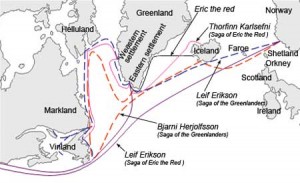Climate, environment and the Norse in the North Atlantic: A bibliography
The Norse colonisation or landnám of Greenland, Iceland, Faeroe Islands, Shetland, and Orkneys from the ninth century CE onwards provides opportunities to examine human responses to climate and environmental change. While Greenland was abandoned, and the population on Iceland struggled, the colonies on the other islands thrived. Because these societies derived from the same origins in Scandinavia, the disappearance of the Norse from Greenland, the struggle on Iceland and success in other places makes it an interesting case study of the fate of these societies and how this is related to the different environments they found themselves in.

Map of Norse sailing routes in the
North Atlantic based on the Icelandic
Sagas. Source: Wikimedia Commons
The case of Greenland is also instructive in another important way: the Vikings encountered people from a different culture: the Inuit. While the Vikings perished, the Inuit thrived and survive until the present day. The tragedy of the Norse in Greenland illustrates that collapse of a human society is not inevitable because it depends on how people respond to environmental changes. The Inuit responded much better than the Vikings and they survived. This message is important for us, facing global warming and environmental change on an unprecedented scale. The way we respond to these challenges will make the difference between collapse and survival.
Below is a short bibliography about the history and archaeology of the Norse and their encounter with the climate and environment of the North Atlantic.
Arneborg, J., Contact, Continuity, and collapse. The Norse Colonization of the North Atlantic (2003).
Barlow, L., Sadler J. et al., ‘Interdisciplinary investigations of the end of the Norse Western Settlement in Greenland’, The Holocene, vol. 7 no. 4 (1997) 489-499.
Barrett, James H. (Ed.), Contact, Continuity, and Collapse: the Norse Colonization of the North Atlantic(Turnhout: Brepols Publishers, 2003).
Brown, Dale M., “The Fate of Greenland’s Vikings”, Archaeology, February 2000. Available online: http://www.archaeology.org/online/features/greenland/index.html.
Coope, G. R., P. D. Moore, A. Gibbs, ‘The Invasion and Colonization of the North Atlantic Islands: A Palaeoecological Solution to a Biogeographic Problem [and Discussion]’, Philosophical Transactions of the Royal Society of London. Series B, Biological Sciences, Vol. 314, No. 1167, Quantitative Aspects of the Ecology of Biological Invasions (Dec. 15, 1986), pp. 619-635.
Diamond, Jared, Collapse: How Societies Choose to Fail or Survive (London: Penguin, 2005), Ch. 6,7,8.
Dugmore, Andrew J. , Mike J. Church, Paul C. Buckland, Kevin J. Edwards, Ian Lawson, Thomas H. McGovern, Eva Panagiotakopulu, Ian A. Simpson, Peter Skidmore and Guðrún Sveinbjarnardóttir, ‘The Norse landnám on the North Atlantic islands: an environmental impact assessment’, Polar Record 41 (2005) 21-37.
Gribbin, John, ‘Climate and history: the West Viking’s saga’, New Scientist, 20 January 1990, pp. 52-55.
Kuijpers, Antoon, Niels Abrahamsen, Gerd Hoffmann, Veit Hühnerbach, Peter Konradi, Helmar Kunzendorf, Naja Mikkelsen, Jörn Thiede,Wilhelm Weinrebe, ‘Cimate change and the Viking-age fjord environment of the Eastern Settlement, South Greenland’, Geology of Greenland Survey Bulletin, 183 (1999) 61–67. Available online: http://www.geus.dk/publications/review-greenland-98/gsb183p61-67.pdf.
Lynnerup, Niels, ‘Life and Death in Norse Greenland’, in: Vikings: The North Atlantic Saga, ed. William Fitzburgh and Elizabeth Ward (Washington: Smithsonian Press, 2000).
McGhee, Robert, ‘The Vikings: They Got Here First but Why Didn’t They Stay?’, Canadian Geographic. Volume 108, 1988, Number 4.
McGovern, Thomas H., and Sophia Perdikaris, “The Vikings’ Silent Saga: What Went Wrong with the Scandanavian Westward Expansion?” Natural History Magazine, October 2000: 51-56.
McGovern, T. H., ‘The economics of extinction in Norse Greenland’ In: Wrigley, T. M. L., Ingram, M. J., and Farmer, G. (Eds.) Climate and History (Cambridge: Cambridge University Press, 1981), pp. 404-433.
McGovern, T.H., ‘Cows, Harp Seals, and Church Bells: Adaptation and Extinction in Norse Greenland’,Human Ecology 8 (1988) 245-275.
McGovern, T. H., Bigelow, G. F., Amorosi, T., and Russell, D., ‘Northern islands, human error, and environmental degradation: a preliminary model for social and ecological change in the medieval North Atlantic’, Human Ecology 16 (1988) 45-105.
Pringle, Heather, ‘Death in Norse Greenland’, Science, Vol. 275, Issue 5302, 924-926, 14 February 1997.
Richardson,Sarah, “Vanished Vikings”, Discover, 21, 3 (March 2000). Available online: http://www.findarticles.com/p/articles/mi_m1511/is_3_21/ai_59535402.
Schlederman, Peter, ‘Eskimo and Viking Finds in the High Arctic’, National Geographic Magazine, 159, 5 (May 1981) 578.
Website: The Greenland Vikings, http://www.holloworbs.com/Greenland_vikings.htm.
Recent Comments